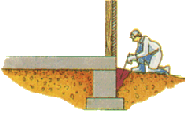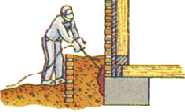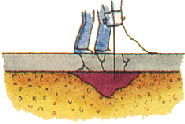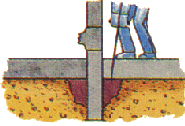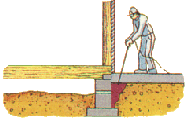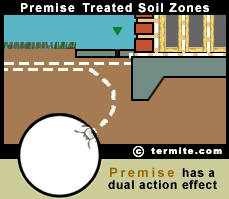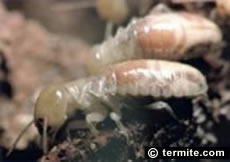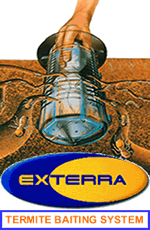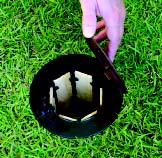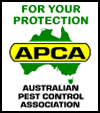 |
Australian Pest Control Association Consumer Advice 1300 660 200 ------------- CLICK HERE To find a Pest Control Company ------------- |
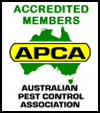
ACCREDITED APCA Members are required to possess TAFE or APCA Pest Control Certificate and extensive field work experience in the pest control service industry ------------- CLICK HERE To find a Pest Control Company ------------- |
| Written by Glenn DuBois - FUMAPEST Sydney Pest Control Updated January 2021
INITIAL INSPECTION & REPORT to Australian Standard 3660 CHEMICAL SOIL TREATMENT to Australian Standard 3660 TERMITE BAITING & MONITORING Systems - Sentricon - Exterra - Nemesis BUILDING MAINTENANCE and MODIFICATIONS REGULAR FOLLOW-UP INSPECTIONS are essential |
||||||||||||
| ► Initial Inspection of Buildings & Surrounds | ||||||||||||
| IMPORTANT first step is to arrange for a professional inspection of the buildings and surrounds together with a written inspection report to AS:3660 Termite Control in Buildings.
The Termite Inspection Report covers areas inspected, inspection findings, high risk areas inaccessible to inspection and other important aspects in determining the recommended options. The cost of a Termite Inspection Report for an average size home is around $250 to $350 depending upon location, the style of construction and ease of inspection access. Areas inspected include all accessible timbers in subfloor (if accessible) roof void, interior, exterior, garden lanscaping areas, fences in the immediate locality - within 50 metres of the building. Specialised equipment may be used - moisture metre, microwave and thermal imaging cameras, Termatrac termite detector, ladders, overalls, torch, timber scribber and extendable dogger. | ||||||||||||
| ► Chemical Soil Treatments | ||||||||||||
| WARNING: General home insurance does NOT cover termite damage to structural timbers.
THE GOOD NEWS: Homeowners can obtain in effect obtain such insurance cover by having a chemical soil treatment to the entire perimeter of a building and any expansion joints in concrete on ground flooring. The termite controller must have Professional Indemnity Insurance for this purpose. If you have FOUND live termites your home we strongly recommend a termite baiting program be carried out for one or two months prior to a chemical soil treatment. It may be highly likely the entire termite colony can be eradicated using professional termite baiting program. Termites by nature have a central colony nest containing a king and queen - soldiers excort hundreds of thousands of workers as they tunnel through soil a 100 metre radius of the nest and build mud-tube gallaries over hard objects and between timber joints to keep airtight conditions. Termites must return to the central colony every few days to feed the colony (liquified timber) including the queen, king, young nymths, soldiers, winged reproductives. Termidor or Premise termiticides are highly recommended due to their deadly delayed effect. Termites travelling through treated soil areas will collect and transport the chemical back to the central colony nest to feed others therein. Highly effective to kill all the termites in a colony. The termite treatment cost is around $2000 to $5000 for an average size home depending on location, type of construction, chemical used, insurance coverage, and warranties applied. THE INSTALLATION OF A CHEMICAL SOIL BARRIER requires expert knowledge and equipment to form a complete and continuous barrier around building - as illustrated below: |
||||||||||||
|
||||||||||||
| Occasionally a sub-nest may exist ie where termites develop a nest in a wall cavity of a home particularly where a regular moisture source exists eg from faulty plumbing or guttering.
Special care and equipment can be used to detect sub-nests in a building incuding a moisture metre, microwave and infrared cameras - but each have their limitations. |
||||||||||||
| ► Pesticide Safety Issues - Soil Treatment Termiticides | ||||||||||||
| There are several types of termite control chemicals registered by the relevant State and/or Federal Government Authority for use in termite control as a soil treatment chemical.
WARNING: Several outdated products are solvent based termite control pesticides which may cause health problems to asthmatics during the drying process. Termidor and Premise are the safer effective alternatives. Both are water based, have virtually no smell and of ultra-low hazard to humans, dogs, cats and other mammals. Termidor is manufactured by BASF, and Premise by Bayer Environmental Science. Termidor and Premise do NOT have an obnoxious odour or emit airborne residues or fumes. Both are registered as a low hazard insecticide with a CAUTION notation on the registered label.
Some alternative termiticides have a strong repellency action to deter foraging termites. Whereas Termidor and Premise are non-repellant to the termites. Termites can enter the treated soil zone without detecting the Termidor or Premise chemical. The repellant nature of other products mean the termites can detect the chemical and will move along the treated soil areas, actively seeking a gap to gain entry into the building.
Premise will act to kill termites, in the higher concentration treated soil areas abutting the building. With Premise, termites that forage in the lower concentrated treated soil areas, will become disorientated, stop feeding, and are fatally diseased by natural fungi and micro-organisms in the soil. Both Bayer Premise and BASF Termidor claim their products will transfer from one affected termite to another ... the technology aimed at eradicating the queen termite and the entire colony - refer to the animated illustration below:
After 250 million years of living underground, subterranean termites have evolved with a very thin waxy skin (called an exoskeleton) that readily absorbs moisture. Premise adheres to the termite exoskeleton and is readily adsorbed through the exoskeleton and into the termite's body to immobilize and kill the affected termite within a few days. The termites spread the Premise to other termites during regular physical contact, particularly when working together in close proximity, grooming and feeding the rest of the colony, a regular function of their daily life. Termites carry away or cannibalize other dead termites, further spreading the deadly effect of the Premise chemical throughout the colony. |
||||||||||||
| ► Termite Baits & Baiting Systems | ||||||||||||
An insect growth regulator affects termites by stopping the moulting process required for the termites to grow. As the worker termites die off, the termite colony declines to the point where it can no longer sustain itself, ultimately leading to it's collapse and elimination.
Both Sentricon and Exterra systems have their own plastic bait stations which must be used with their product. These bait stations can be placed in the ground and checked regularly. Termite colony elimination in favourable circumstances may take several weeks to a few months. However, in some cases, termite colony elimination is unsuccessful or may take years, depending on the circumstances. Where a large number of termites find and connsume the bait, then colony elimination is virtually assured within a few months. This is where the experience and skill of the termite controller is paramount to decide if and where a baiting program is implemented and properly monitored. Both the Sentricon and Exterra termite baits are designed to be slow acting, non-repellant and therefore spread to other termites in the colony before the colony can detect where the deadly effect is coming from. Termites have acute survival instincts. The location of a toxic food source if detected, will be abandoned. Too much disturbance of the foraging termites (workers and soldiers) in a particular location, will alert the termite colony to abandon the area. The termites appear to be gone, but may in fact be entering the building in other areas. Your home is a much bigger bait station. Both the Exterra and Sentricon termite baiting systems are subject to regular inspection and monitoring by the termite controller. The larger the number of termites that consume the bait, the quicker and more certain is the termite colony elimination process. It is usual to reinspect the bait stations and the buildings and surrounds every month to reposition, reapply or replenish the bait, if necessary. This process is labour intensive so that the long term cost of the monitoring / baiting system may accumulate out of hand before the chance of success or otherwise, is realised. Ring the Experts: successful termite protection of a building using a baiting program often requires expert skill and judgment, based upon years of field-work experience in termite control in a wide variety of circumstances. One critical aspect is the bait stations should to installed in areas where termites are more likely to be foraging. The termites must "find" the stations to have any chance of success. CONSUMER NOTICE: Be wary of any advertising or promise that a timber replacement warranty applies as regards subsequent termite damage to a building using a termite colony elimination system. Does this Contract stipulate in the fine print that the so called "warranty" may (or may not) apply at some future point in time to be decided by the company? With a termite baiting program, there can be no absolute guarantee of long-term protection of nearby buildings. There may be other termite nests nearby the building that do not find the bait stations. Your home is a much bigger bait station. Other termite nests may exist in trees, under concrete on-ground flooring and in-fill patios of neighboring properties. The Sentricon baits are placed in their in-ground bait stations after removal of the termite infested timber therein. This may involve sufficient disruption of the termites such that they avoid the in-ground Sentricon bait station, entirely. This serious short-coming is overcome by the patented Exterra Termite Stations where the timber is aligned around the cylinder such that the bait can be inserted without such disturbance of the termites present. RECOMMENDATION: Exterra or Sentricon be used where a complete chemical soil barrier treatment using Termidor or Premise is not practicable or desired, and where a several thousand termites are likely to eat the bait. A termite monitoring and baiting program can be integrated with a range of methods including (1) drilling susceptible trees and eradication of any termite nest located therein, and (2) in conjunction with a follow up chemical soil treatment using Termidor or Premise. |
||||||||||||
| ► Building Modifications & Maintenance | ||||||||||||
| Rapid termite colony development and building infestation is usually associated with a readily available timber food and moisture source nearby the central nest. In addition, buildings are often constructed in a way that allow termites to gain undetectable entry from the soil to the structural timbers of the building. Listed below are some useful recommendations for the home owner to carry out in order to reduce the risk of termite activity inside a building.
Moisture exclusion from inside the wall cavities, around the base of the building and sub-floor area (if any). Water run-off can be excluded from a sub-floor area by the installation of ag-drains. Make sure there is adequate cross flow ventilation in the sub-floor area. In addition, a qualified plumber should be engaged to ensure there is no water leakage from plumbing pipes in the bathroom, the shower recess, kitchen, down pipes, guttering and air conditioning unit overflow. Look for signs of dampness in the wall cavities, broken roof tiles, faulty guttering and the like. Please note: high humidity, dampness or moisture accumulating in a wall cavity is of high risk to encouraging large scale termite activity inside the building. Removal of any timber in contact with the soil. Timbers should be stored above ground to allow full inspection of subterranean termite activity (coming from the soil thereunder). Any landscaping using timber chip mulch and railway sleepers should definitely be removed, as they provide ready food source to assist in rapid termite colony development. Ensure inspection access is unimpeded, particularly in sub-floor areas (suspended floors) in order to look for evidence of termite activity. If your property is on a concrete slab on ground flooring, make sure you can inspect the entire external slab edge for evidence of termite mud-shelter tubes. Do NOT allow this area to be covered by pavers, landscaping, planter pots, etc, as termites often gain entry into the walls of a building via this locality, particularly through external weep holes and minute (2 mm) gaps in the mortar in brick-work. If you find live termites or termite damaged timbers DO NOT disturb the area. DO NOT use spray can or insecticides on the termites. If sufficiently disturbed, the termites are likely to move elsewhere, and may not be rediscovered until further obvious damage has been done. The termite controller can introduce Intrigue termite dust or Exterra termite bait directly to the live termites present in an attempt to eliminate the entire termite colony - as discussed in detail above. |
||||||||||||
| ► Regular Follow-up Inspections & Monitoring | ||||||||||||
| Consumer Note: the installation of a chemical soil barrier does not negate the need for regular competent inspections - at least 3 to 6 months where the termite risk is high.
We recommend 3 or 6 monthly inspections be carried for the first 2 years after a chemical soil treatment. Monitoring of "stand-alone" baiting systems should be carried out every 4 to 6 weeks. BE AWARE the correct identification of destructive termite species, inspection of a building for tell-tale signs, analysis of circumstances and implementation of an effective termkite control program requires expert skill and judgement based upon professional training and extensive field-work experience in termite control in a wide variety of circumstances. Contact a Local Expert - NSW - ACT - VIC - SA - WA - QLD - NT |
||||||||||||
